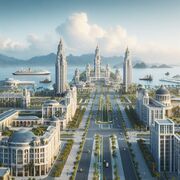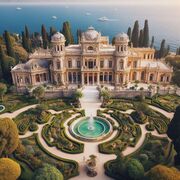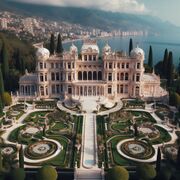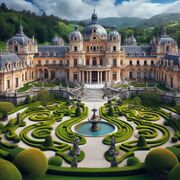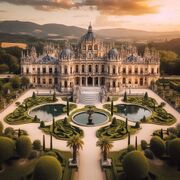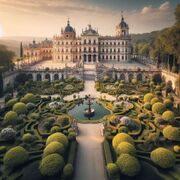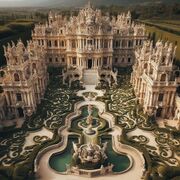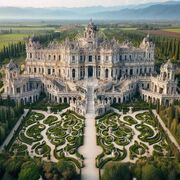Culture in Burgundie

| This article is part of a series on the |
| Culture in Burgundie |
|---|
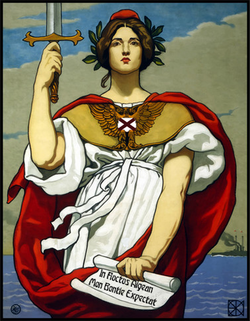 |
| Society |
| Arts and literature |
| Other |
|
Burgundie portal |
Culturally, Burgundie is one of the least vernacular and most mechanical nations in the world. This means that there is a level of homongony across the diverse and vast thalattocracy. This is an accidental side effect of the centralized, planned mechanization put forward by the various royal institutions since the New Burgundie Secession War, but especially since the Second Great War. These mechanization efforts, namely in the wide spread use of air conditioning, mass transit, and subsidized domestic migration have allowed the Burgoigniacs to live anywhere in the world under the same conditions as they would on the Ile Burgundie. Many international sociologists term this Laissez-faire Vilauristrification in reference to the fact that the phenomenon was accidental and that the Burgoignesc cultural experience is becoming more like that of the capital in Vilauristre. This has been more noticeable in the Burgoignesc territories outside of the Burgoignesc Metropole, as Levantine Burgoignesc culture is the core that many other vernacular cultures within the thalattocracy are being pulled towards. Outside of Burgundie, this has been observed across southern Audonia and western Alshar. Many in these areas see Burgundie as the paragon of modernization and progress and thus have adopted many of the mechanizations that have led to this shift in Burgundie.
Class and Work
Social stratification
Burgoignesc society is divided on a number of lines that crisscross familial ties, geographic origin, ethnicity, and professional station. Ones status is taken on the whole so it is possible to have a higher "ranking" in one category but an abyssmally low "ranking" in another and you are therefore viewed as having an average societal status. These stem from the ancient noble stratifications of the post-classical era of the Kingdom of Dericania. By that period that ruling class of coastal Dericania was distinctly more Bergendii than any other culture and the families who helped to establish that cultural shift wanted to maintain their power.
The Alavar, Palacin, Marialanus, Marius, Galen, and Jacobi make up the Six Royal Houses of Burgundie who constitute a portion of the X Estates of Dericania. The "high" noble houses (estates in the Imperial context) rest a top 20-odd patrician houses or the urban aristocracy, a later development that became increasingly powerful after 1848 and the abolishment of the nobility. While the Royal Six still exercises disproportionate power, by the mid 20th century its fortunes were more or less lumped in with the patrician houses and they are collectively known in society as the "nobility".
Professional stratification
Geographical stratification
Uplanders
The Uplanders, reside in the interior of the Burgoignesc Metropole, namely the provinces of Provinces of Esquinia, Alexarmes, Laclionia, Montverd, and Orostile. They form a distinct societal group characterized by a robust work ethic, unwavering honesty, and a close-knit community spirit. While their diligence and hard work are admirable, the Uplanders often face economic challenges as these provinces never enjoyed the material wealth and therefore infrastructure investment, resulting in a relative lack of affluence and academic attainment compared to their urban counterparts, the Culture in Burgundie#Metropolitans. In this rustic setting, societal norms are deeply rooted in traditional values, emphasizing the importance of community cohesion and familial bonds. The Uplanders take pride in their agricultural and mining pursuits, with many families engaged in farming and livestock activities that have been passed down through generations. These vocations serve as the backbone of their livelihoods, fostering a strong connection to the land and a sense of self-sufficiency. Education, though valued, may face limitations in the Upland communities, contributing to a perceived lack of polish. Despite this, the Uplanders possess a wealth of practical knowledge and skills, honed through hands-on experiences in agriculture and craftsmanship. There is an intrinsic appreciation for manual labor and a resourcefulness that defines their approach to daily life.
The Uplanders' close-knit communities are characterized by a shared sense of responsibility and mutual support. Neighbors often come together during times of need, engaging in communal efforts such as times of hardship/disasters and harvest festivals, reinforcing the collective spirit that defines Upland society. Social gatherings and local events play a vital role in strengthening community bonds, offering a platform for shared traditions, folklore, and cultural practices. Religion holds a significant place in Upland life, with many communities maintaining a devout adherence to traditional Catholicism. Religious ceremonies and festivals are celebrated with fervor, providing occasions for communal worship and reflection. The Uplanders find solace and guidance in their faith, contributing to the moral fabric of their society.
Metropolitans
The Metropolitans, Bergendii reside along the coast of the Burgoignesc Metropole. They form a distinct societal group characterized by a vicious work ethic and business acumen, but gave less of a community spirit then the Uplanders. They have high levels of academic attainment.
Ostiecians
Ostecians are characterized by their predominantly Mercantile Reform Protestant faith and traditions, shrewd Protestant work ethic.
Islanders
Ostiecians
Islanders
Ethnicity
While often confused, the Bergendii are only a fraction of those who carry the demonym Burgoigniac. The term Burgoigniac refers to all peoples who reside in Burgundie, regardless of their ethnicity.
Derian
Bergendii
Of the Burgoigniacs, the Bergendii are the largest ethnic group. Sometimes referred to as ethnic Burgoigniacs by other cultures, this group is pervasive across many nations around the world. However, only those who originate from the Latinic group that populated the Ile Burgundie between 100BC and 11th century AD are considered Bergendii. This Latinic group created a divergent culture with its own traditions and language, and after turning on the Latinic Arani of Dercania, most scholars think that they had become a unique group. Their phenotype also paints a picture of some limited genetic mixing with local ethnic groups, which their linguistics and traditions support.
Common characteristics are that they speak Burgoignesc, they are primarily Levantine Catholic, although there is a sizable minority of Mercantile Reform Protestant in Flordeterra and the Burgoignesc Minor Overseas Territories. They are generally paler, taller, and fairer than their Latinic brethern, due to intermixing with the indigenous populations of northern Levantia.
Sinitalian
While genetically part of the Latinic phenotype, the Sintalians are a culturally unique group in central eastern coast of Levantia. In Drusla, Esquinia, and Pumbria the Sinitalians are the majority group. The Sintalians have dark features, are shorter and squatter then their western Latinic cousins. They speak Sintalian, an off-shoot of Latin that is so idiomatic and influenced by other languages brought to them by seafaring people, including Burgoignesc, that linquistically it is considered separate from Latin. The majority of Sintalians are Levantine Catholic but about 15% practice Judaism.
Feinii
The Feinii of Burgundie, are a subgroup of the greater Levantine Prythones. They make up the majority of the population in Ultmar, but are only the second largest group in all of Burgundie. They often complain of unequal treatment at the hands of the Bergendii establishment. They are tall, pale, a large part of the population have red or fair hair. They are primarily Levantine Catholic but as a sign of resistance against the "foreign" Latinic rule of the Bergendii, some more radical groups adopted [[Wikipedia:Afrikaner Calvinism|Punthite Mercantile Reform Protestant]] and Mormonism in the early 20th century. While these groups are small, about 6% and 3% respectively, they have become some of the most outspoken in favor for addressing the "inherent rascism" in Burgoignesc society.
Impaxi
Other Ethnicities
Ænglish
The Ænglish are a group of people of northern Urcea. They settled in the area after being brought into the area by the Urcean king in the mid-14th century to form a liege army. The area became known as Angla region in the 1400s as they became the most pervasive culture. They emerged as a unique culture with a unique language around that time and their central location and amalgous language, they provided a bridge between the various Germanic, Feinii, and Latinic cultures in Levantia. Despite being crushed and subsumed into Urcea, their language, English, became very pervasive in the 1500s as a working language of Levantia.
Arani
Other ethnocultural groups in Levantia include the Arani of southeastern Faneria, the Kirhavite Aboriginal tribes, and the Coscivian peoples who migrated from distant Novērda to become the majority in Great Kirav and Uruvun.
Kharkaars
Sondsteadish Tatars
Religion
Catholicism
Catholic Church
List of Christian primates
Circuit rider (religious) but Catholic vs Clerici vagantes
Saddlebag priests organized under the Tarsusian Order wander the countryside looking for poolhalls and other poignant topics in need of a pearl clutch and then foment panic in the middle class to solicit donations to "solve" social ills through the "power of prayer", but with some Catholic spin on it so its not literally the most Protestant sentence in Christendom.
most influential orders were the Cisternians and later the Trappists
Mercantile Reform Protestantism
Cauvinisme lots of it, mostly in Equitorial Ostiecia.
Other Christian Faiths
Mormon Church
Islam
Judaism
The migration of the Jewish people from the Kingdom of Eshel has left an enduring imprint on the cultural fabric of Burgundie, fostering a diverse and vibrant Jewish community that is now an intrinsic part of Burgundie's society. Over the centuries, especially during the Burgoignesc colonization of southwestern Audonia, leading to the dispersion and integration of the Eshellim into various polities within the Burgoignesc thalattocracy. In the Martillien Istroya Oriental colony, Jewish communities from Eshel found new homes, bringing with them their unique traditions, language, and religious practices. This cultural synthesis in the colonies became a defining chapter, as the Eshellim integrated elements of Burgoignesc culture while preserving their distinct Jewish identity. The coexistence of diverse communities laid the groundwork for the enduring presence of Jewish communities in Burgundie. Engaging in various professions, from trade to craftsmanship, Jewish migrants became integral to the economic success of the Burgoignesc thalattocracy. Over time, they established vibrant neighborhoods, synagogues, schools, and communal spaces in urban centers, contributing to the economic and cultural landscape. The descendants of the Eshellim continue to contribute to the nation's cultural mosaic. Their integration is evident in daily life, from culinary practices to religious observances, reflecting the enduring impact of this historical migration. The descendants of the Eshellim have made significant contributions to various fields, enriching Burgundie's intellectual landscape. Burgundie's commitment to religious tolerance and pluralism has allowed Jewish communities to thrive, fostering an environment where diversity is celebrated. Dialogue between different religious communities, including Jews, promotes unity and harmony among Burgundie's diverse populace.
In modern Burgundie, the Jewish community has maintained a strong identity, preserving key aspects of their religious heritage while adapting to the cultural milieu of the nation. The observance of Jewish holidays in Burgundie is marked by a combination of traditional rituals and local customs. For example, Passover celebrations may feature traditional Eshellim dishes alongside Burgoignesc cuisine, symbolizing the intersection of cultural and religious practices. Similarly, Hanukkah festivities may include local variations on traditional foods, emphasizing the adaptability of Jewish customs to the local context. The preservation of kosher dietary laws is a central tenet of Jewish life in Burgundie. Despite the predominantly pescitarian nature of Burgoignesc diets, Jewish communities adhere to strict kosher guidelines, ensuring that their food adheres to the dietary laws outlined in Jewish scripture. This commitment to kosher practices has created a niche market for kosher-certified products and has contributed to the diversity of culinary offerings in Burgundie. The unique history of Jewish migration from Eshel has also led to the development of distinct religious practices within the community. Certain prayers and liturgical elements bear the influence of Eshellim traditions, creating a sense of continuity with the ancestral homeland. Additionally, the observance of certain fasts and commemorative days may carry historical significance related to the experiences of the Eshellim in the Burgoignesc thalattocracy.
Religious Festivals
Language
The official languages of Burgundie are Burgoignesc and Latin, but Burgoignesc is the national language. Burgoignesc is taught in all years of primary and secondary education. Latin is taught in primary school and for the first two years of secondary education in the Burgoignesc Metropole. Due to the vast expanse of the Burgoignesc Thalattocracy, territories outside of the Burgoignesc Metropole replace Latin education with their primary local language.
Naming Conventions
In Burgundie, the quadnomina is the most common naming convention among the Bergendii who form a majority of the population.
Praenomen primus (PP), the given name, prenomen familius (PF), an ancestor you respect or whose traits you want your child to portray (like modern middle names), Nomen (NG), typically the mother's last name or lineage on her side she wants to honor, and a Nomen Familius (NF) the father's last name/lineage. It is written PP-PF NG NF e.g. Carl-Emile Vossage d'Esstange.
Body Language
Education
Maternal school
Primary and Secondary Education
Primary and secondary education is mandatory in Burgundie. Burgoignesc parents value education above all else for their children. In addition to public schools, magnet and charter schools thrive. Private schools like independent, parochial, Montessori, and Waldorf schools serve 60% of the primary and secondary students in Burgundie. Families are very receptive to the varied learning styles of their children and often choose schools based on their children's needs, as well as their prestige. As such, the children of Burgundie have some of the highest literacy rates at 99% and about 90% of young Burgoigniacs pursue some form of tertiary education.
Public School
The public school system in Burgundie is administered and run by the Catholic Church. The Ministry of National Education (MONE) oversees the development of a secular curriculum based on the Istroyan enkuklios paideia "well-rounded education" which is a minimum standard for the Church's public schools. The MOE is primarily an inspection and enforcement agency and has commensurate authorities.
Primary Education
| Year of instruction | Quadrivium | Trivium | Religious education | Fitness and Movement | Notes |
|---|---|---|---|---|---|
| 1st Grade | |||||
| 2nd Grade | |||||
| 3rd Grade | |||||
| 4th Grade | |||||
| 5th Grade | |||||
| 6th Grade |
Secondary Education
| Year of instruction | Quadrivium | Trivium | Religious education | Fitness and Movement | Notes |
|---|---|---|---|---|---|
| 7th Grade | |||||
| 8th Grade | |||||
| 9th Grade | |||||
| 10th Grade | |||||
| 11th Grade | |||||
| 12th Grade |
Tertiary Education
Burgundie has the highest tertiary education participation rates in Ixnay with about 87% of the adult population having some form of post-secondary education. These programs are classified as Specialized Baccalaureate (SB), Associates (AA/AS), Bachelors (BA/BS), Graduate Certificate (GC), Masters (MA/MS), and Doctorate (varies, depending on the program). Higher education in Burgundie is entirely privatized but, by royal degree, must be run in a non-profit model. This means that many universities, institutes, and academies have diversified beyond just their educational mission. The Seager Corporation (The President and Fellows of Seager Akademi) have led this trend with investments in a variety of museums, private libraries, laboratories, a vineyard and private forests. All of these forms of diversification are run for the benefit of the educational community, but generate a healthy profit for the institutions that operate them.
College
University
Academy
Institute
Accredidation
Private Acreddidation
Royal Charter Acreddidation
Government Charter Addredidation
Quartiary Education
While there are no requirements or standards around quartiary education (continuing education and professional development) in Burgundie, about 48% of the workforce engage in some form of quartiary education annually. There are approximately 954 accredited continuing education or professional development programs in Burgundie. These courses are heavily biased towards the technical fields of engineering, architecture, mathematics, and sciences but almost every type of work in Burgundie maintains its own professional organization with certification criteria.
Associations
Certification Societies
Orders
Post-doctoral Work
Oligarchia grammaticorum
Starting in the 1420s a meeting of learned men from the Faneriai principality of Burgundie, Heku, Kiravia and Paulastra occurred to discuss the status of the world. These meetings occurred in 1424, 1426 and 1429, but was outlawed as some topics were considered blasphemous. In 1430, the group formed a codex and started to send encrypted messages to each other and so began the Oligarchia grammaticorum (OG), Oligarchy of Grammarians. Their encryption grew ever more difficult to crack and the imagination of the world was taken by storm. There were conspiracies about every event and the involvement of the Oligarchia grammaticorum. In the 1640s the oligarchy became more transparent and started a number of permanent literary and scientific academies, most notably Universitas Magistrorum in Burgundie, _________ in Heku, Universitas Codicis in Kiravia, and Farpoint University in Paulastra. In the 18th and 19th century the OG was a driver in Enlightenment thought in Northern Levantia and Kiravia but its members suppressed the liberal ideals in Heku and Paulastra. By the 20th century, the OG had become primarily a learned society and a philanthropic entity. At the dawn of the 21st century, the OG has broadened its scope to also include artificial intelligence and cyber technology. It was under the guidance of the OG that Burgundie released its colony at Argaea to become Ixnay's first technocracy.
ARGUS
Science and Technology
Medicine
Healing
Despite the preference for evidence-based medicine in the majority of cases, alternative medicine has, since the 1980s, had an increasing impact on the preventative care environment in Burgundie. While evidence to support these forms of healing as curative is scant, the medical community is generally accepting of them as part of a continuum of care as long as they are not the sole and ultimate form of care sought by the patient.
Halotherapy
Stemming from the old colonial practice of “taking the salt” in Bulkhawa colony in the 18th century, halotherapy (salt immersion therapy) has become popular again across the nation. The best spas have salt imported directly from Bulkh, but a variety of mineral salts are used in common spas.
Sulin medicine
Following the defection of Surgeon General Zhao Su Lin from Xingkai’pei in 1982 to Burgundie a craze for traditional eastern medicine ensued. Zhao made millions off of book tours, medical tourism summits, and opening franchises of name branded Reiki, Acupuncture, Acupressure, and Qigong studios and spas. Sulin became the byword for traditional eastern medicine, a branding effort his public affairs team encouraged.
Faith healing
Since Burgundie is a majority Catholic country, the Church has a monopoly on faith healing. While a variety of parochial evidence-based medicine hospitals and paramedical services exist, there are services offered for those who prefer Faith healing as well. Not all parish priests are trained in the conduct of healing services, but parishes where the practice is more accepted typically have priests who are so trained. All priests in Burgundie are well acquainted with the appeal for the Intercession of saints and it has been anecdotally acknowledged that large swaths of the population seek this practice.
Psammotherapy
Stemming from the ancient sand baths of eastern Audonia, Psammotherapy (Burg: sammotherapie), is the total immersion of the body in hot sand, with the exception of the head. It is typically done in the desert but lacking native deserts Burgundie saw a rise in the 2020s of sand bathing beds. The participant lays in a shallow pit in the deserts surface sand and is then covered in a thick layer of sand causing the body to sweat profusely for up to 10 minutes. Then the participant is help out of the sand, is wrapped in a warm blanket and escorted into a tent were they drink large amounts of water. The process is repeated on average four or five times. The effects on the body are the same as a sauna but with dry heat versus moist heat.
Balneae
Time
Division of the year
Burgundie uses the Levantine Calendar, but has names in Burgoignesc for the months.
| No. | Name | Burgoignesc | Meaning | Note |
|---|---|---|---|---|
| 1 | January | Guili | Yule | The month starts (eve of December 31) with the burning of the yule log (Burg.: cacha-fuoc), commemorating the solstice and the beginning of the lengthening of days. In this month, the Church celebrates the Feast of the New Year. |
| 2 | February | Februarius | of the purification | In this month Lent begins and Christian Burgoigniacs purify their souls in preparation for Easter, Christ's resurrection. |
| 3 | March | Viatge | of travel | In this month winter ends and, in antiquity, the trade ships would leave the Burgoignesc harbors for the first voyage of the year. |
| 4 | April | Pasqua | Easter | Commemorates the resurrection of Christ. |
| 5 | May | Proserpina | of Proserpina | Commemorates the ancient goddess Proserpina, the bringer of the Spring. In this month, the Church celebrates the Feast of Saint Proserpina, which they maintain is unrelated. |
| 6 | June | Iuniores | of youth | In this month, the Feast of Youth is held, often correlating to many wedding ceremonies. According to ancient customs, it is considered good luck to get married in Iuniores, and prestigious to be able to be married on the Feast of Youth. |
| 7 | July | Nadal | of the birth of Christ | To commemorate Christ's birth. |
| 8 | August | Julhet | of Julian | In this month, victory of Julian Marcilius Corvus Bergendus over the Impaxi/Levzeish forces, establishing the precursor to modern Burgundie. |
| 9 | September | Auristre | of the hurricane | In this month marks the height of the Levantine Ocean hurricane season. |
| 10 | October | Hasif | of the ingathering | This month marks the end of the "Israelites" exodus in "Egypt", of the harvest, and of hurricane season. The ingathering refers to the collecting of the "Israelites" back into "Israel", of the crops into the barns, and of the ships into the harbor. It is a time of thanksgiving and of preparation for winter. |
| 11 | November | Sang | of blood | Commemorates the sacrificing of animals to the old gods. The Church celebrates the Feast of the Deprevation, which features the sacrificing of animals for their meat, in preparation for winter. |
| 12 | December | Crist mass | Christmas | Commemorates the celebration of Christ's coming. |
Division of the day
Most Burgoigniacs and almost all businesses divide their day based on the watchkeeping practices of the Merchant Marine of Burgundie and the Navy of Burgundie.
| Maritime name | Time | Civilian name | Typical activities | Notes |
|---|---|---|---|---|
| First watch | 2000–0000 | Premier sommiel "pre-som" (First sleep) | Sleep | Sleep for 3-4 hrs then a period of being awake for an hour or two |
| Middle watch | 0000–0400 | Deuxieme sommeil "deax-som" (Second sleep) | Sleep | Conclusion of the midnight activity and 3-4 hours of sleep |
| Morning watch | 0400–0800 | Rompre jeune (Breakfast) | Preparing for the day, eating the first meal, commuting to school or work | N/A |
| Forenoon watch | 0800–1200 | Matinee (Forenoon) | Work/school | N/A |
| Afternoon watch | 1200–1600 | Midi (Midday) | Lunch, work/school | N/A |
| First dog watch | 1600–1800 | Apres-montre (after watch, similar to Feierabend and apres-ski) | Happy hour, relaxing with friends, commuting | N/A |
| Second dog watch | 1800–2000 | A maison (at home) | Dinner, light cleaning, getting ready for bed | N/A |
The traditional watch system arose from sailing ships of the late 19th century and was used by the Navy of Burgundie and the Merchant Marine of Burgundie. It consisted of 5 four-hour periods and 2 two-hour periods. It shifted considerably during the Industrial Revolution to fit factory schedules better, but since de-industrialization in the 1960s this system has come back.
Cuisine
Food
Due to its history of Trappist monasticism and its proximity to the seas, almost all Burgoignesc diets are pescitarian. For poor Burgoigniacs particularly in the "uplands' of the Burgoignesc Metropole "four-footed animals", are, out of necessity, also an important part of their protein repertoire. Since the advent of refrigeration, this has been less of an issue, but the tradition is still strong despite the waining influence of the Catholic Church.
With recently created floating farms, the increase in grains and root vegetables has seen a slight increase in the national average of weight. Previous to this, carbs had played a fairly small part in the Burgoignesc diet. Vegetables and fruits from around the world are important as well. Because most foodstuffs in Burgundie are imported (with the exception of fish), they are comparatively expensive. This means that grocery bills in Burgundie constitute a higher proportion of a family's expenses than most countries. Families often share meals with neighbors and larger families in order to pool resources and afford more expensive foreign imports. This communal style of meal sharing has created a strong sense of community and camaraderie across the country. These "meal groups" (Burgoignesc language:grup de menjars) operate as extended families.
Levantine cuisine
Oysters
Oyster#As_food, Eastern oyster Unlike most shellfish, oysters can have a fairly long shelf life of up to four weeks. However, their taste becomes less pleasant as they age. Oysters should be refrigerated out of water, not frozen, and in 100% humidity. Oysters stored in water under refrigeration will open, consume available oxygen, and die.

Oysters can be eaten on the half shell, raw, smoked, boiled, baked, fried, roasted, stewed, canned, pickled, steamed, or broiled, or used in a variety of drinks. Eating can be as simple as opening the shell and eating the contents, including juice. Butter and salt are often added. In the case of Oysters Rockefeller, preparation can be very elaborate. They are sometimes served on edible seaweed, such as brown algae.
Care should be taken when consuming oysters. Purists, a common occurrence in Burgundie, insist on eating them raw, with no dressing save perhaps lemon juice, vinegar (most commonly shallot vinegar), or cocktail sauce. Upscale restaurants pair raw oysters with mignonette sauce, which consists primarily of fresh chopped shallot, mixed peppercorn, dry white wine and lemon juice or sherry vinegar. Like fine wine, raw oysters have complex flavors that vary greatly among varieties and regions: salty, briny, buttery, metallic, or even fruity. The texture is soft and fleshy, but crisp on the palate. Variations in water salinity, alkalinity, and mineral and nutritional content influence their flavor profile.
Equatorial Octiecian cuisine
Pukhtunkwan cuisine
Fusion cuisine
Alcohol
Burgoigniacs have a long history of alcohol appreciation. Proto-Bergendii left behind a tradition of spit beer that lasted well into the middle ages. As the agricultural practices of Burgundie improved, large fiefs and Trappist abbeys started to focus on viticulture and brewery-based agriculture. As a result, barley beer, Trappist beer being among them, became popular. It was also the beginnings of the modern Burgundie Wine Region. In the 1600s, Kiravian whiskey distilling methods improved to the point of abundance, and exports of whiskey started arriving in Burgundie.
Barley beer fell out of favor in the mid-1700s when ships carrying sugarcane from near the equator resulted in a rum boom. This was also coupled with a conservation effort to restore the cedar forests of Burgundie, which curtailed agricultural expansion. Political difficulty with Kiravia resulted in a formal cessation of the imports of Kiravian whiskey, but "whiskey packets" thwarted the sanctions and a black market built up around it. The Burgoignesc government tried to subsidize local distilleries and created a unique blend, made mostly of corn mash called Burgbon, but the product was sub-par and never caught on in discerning markets.
In the 1970s, after the repair of relations between Burgundie and Kiravia, Kiravian whiskey was formally allowed to be imported into Burgundie once again. Recently, Cair Sinclair distillery in Avercrósan, Irovasdra, Kiravia, has become the most popular imported whiskey brand in Burgundie, clinching a $40million share of the liquor market.
Gin and Tonic Race

Main article: Kiro-Burgoignesc Gin & Tonic Race The Gin and Tonic Race was a mercantile kerfuffle in the 1800s between Burgundie and Kiravia resulted in Burgundie dominating the Greater Levantine gin and tonic water markets. To this day Vilauristre Dry Gin and Yonderrian Sloe Gin are considered mass-market standards in most countries.
Caffinated beverages
Portions and sizes
Dieting
Philosophy
Logic
Functionally ordered society
Burgundie has a above average historical bent to group like things along functional lines (e.g. Vocivine National of Burgundie and Rail_transportation_in_Burgundie#Chain_boats. This is an outgrowth of the medieval and early-modern guild and late modern scientific management movements that defined what would be termed "functionally ordered society" or "streamlined social organization theory" in the 20th century.
Metaphysics
Natural philosophy
Moral philosophy
Theology
Social prudence
Burgoignesc society is predicated heavily on the moral prerogative of a righteous Civil society. This has long been the breeding ground for the Social contract that developed in Burgundie. It stipulates that the Commonwealth is best served by citizens who are highly independent and intelligent, mindful of their action’s impact on others, and knowledgeable of the definite difference between right and wrong. The concept of a “moral grey area” is a fairly recent development and is mostly utilized solely overseas as an instrument of trade or politics.
This sense of establishing a morally righteous community has long been supported by the Catholic Church, allowing for the Church to dig its presence deep into the societal consciousness of the average Burgoignesc citizen. This is best expressed through a 2023 study on Queueing theory, in which Burgoigniacs came in first for the populations most compliant to queues and first for populations most violent against those who thwart queues. In the study's final remarks, it was noted, "that while not scientifically significant it was observed that a Kiraviaian, recently arrived in Vilauristre, was first verbally, then physically assaulted by Burgoigniacs in line at an ice cream parlor. So vicious were the Burgoigniacs in their assumption that the Kiraviaian had spit in the very eye of the Burgoignesc ethos, that it took 12 police officers 5 minutes to restore order.”
Other tenants of the latent code of Burgoignesc conduct are as follows:
- a crime against one Burgoigniac is a crime against Burgundie as a whole, this applies doubly for crimes against women and children, often leading to community ordained vigilantism
- poverty is a result of the complicity of society and therefore, it’s existence is the fault of each individual Burgoigniac
- clothing is a demonstration of respect, therefore, not wearing the appropriate clothing to the occasion is a slight against society as a whole
The Burgoigniacs look down on societies who do not follow these particular tenants. This is particularly the case on the continents of Levantia, Crona, and Ixnay, as the expectation is that also being from a Judeo-Christian background they would follow similar tenants. It has also led to a paternalistic approach to nations outside of the Abrahamic traditions. As a result of these strict social morays, Burgoigniacs are generally looked upon as snobby, self-righteous, condescending, and morally heavy-handed.
Heritage
History and heritage are very important to the Burgoigniacs. These leads them to tend toward traditional social morays and cultural interaction. That is not to say that Burgoigniacs are closed or narrow-minded. They welcome other cultures and scientific and technological advancement as these have always been important to the monetary and cultural economy in Burgundie. Furthermore, there is a certain yankee ingenuity that Burgoigniacs are known for throughout Greater Ixnay. They are renowned hard workers, shrewd businessmen and extremely devoted to the commonwealth of Burgundie.
Burgoigniacs are very proud of these qualities, in fact, they are proud people in general, but often in a stoic way, never braggadocious or boastful.They sense of assuredness is often perceived by less formal cultures as antiquated and snobby.
In a bit of jingoistic Kiraviaian reportage the Burgoignesc culture was likened to a strong cup of tea, steeped in its own self-importance, bitter to the foreigners taste, but viciously effective at jolting the system.
Folklore
Traditions
Thalassophila
They love the sea, like a lot. The national motto is In Fluctus Aigean Mon Bontie Expectat (Aeng: Upon the Ocean Waves My Bounty Awaits).
Imperialism and Colonization
The foundation of the Burgoignesc Colonial Empire was to seek out the kingdoms of the Biblical Magi and to unite "all the lands whose kings adored Christ". As such, at least at its genisis, what has been retrospectively termed a Mission civilisatrice, was the search for co-equal kingdoms with which to join forces in service of Christ. The thesis that Balthazar, Melchior, and Gaspar came from Christian kingdoms was flawed from the start and meant that the Papally ordained/funded explorations of the coastal Derians never found what they were looking for. It did however, lead to a self-righteous bent of Imperialism and settler colonization that spanned Audonia and Alshar in the 17th, 18th, and early 19th centuries. Exploration and colonization in northern Audonia was justified under the banner of searching for the kingdom of Balthazar, the same for southern Audonia in search of Melchior, and same again in Alshar in search of the kingdom of Gaspar. This earning for oriental connection remains to this day but has been informed by many other factors beyond this initial concept.
This is also retrospectively used to describe Burgundie's general lack of interest in the colonization of Crona.
Slavery
Slavery is recognized as an abhorrent practice, but an integral part of the history of Burgundie. The contributions of slaves are embraced as part of the foundation of Burgoignesc society. History of Burgundie is taught to include the ever-present role slavery played in the Latin Heroic, Great Levantine, and Holy Levantine Empire periods, falling out of fashion in the 1830s, and being formally being banned in 1875. Furthermore, people whose forebearers were brought to Burgundie through the practice of slavery are considered equal members of Burgoignesc society and whose freedoms and obligations are the same as every other Burgoigniac.
Slavery does not carry the stigma of "otherness" as slavery was not uniquely practiced toward any one group or ethnicity in particular. Who was enslaved by the denizens of the principalities that makeup Burgundie was based purely on ease of access. In the Latin Heroic Age, throughout the reign of Great Levantia, and the majority of the Holy Levantine Empire period, Occidental slaves were taken from neighboring principalities, northern Levantia, and the Sarepdonian coast of the Sea of Istroya. As maritime technology improved and these areas centralized and became difficult to raid, Bergendii slavers looked further afield. In the middle Holy Levantine Empire period, Bergendii slavers took over the existing chattel networks as the Oduniyyad Caliphate collapsed. They used their pharisedoms as slaving hubs and as slave markets and enslaved around 10 million people of Audonian origin and transported them all over the world in the 17th, 18th, and early 19th century. However, this was merely one part of a global slave market reticulum that started a global decline in the 18th and 19th centuries.
Stigmatizing slavery and therefore ignoring the role it played in the development of the societies it help build, and sidelining the descendants of slavery is considered a stupid thing done by libtards and conservacucks alike.
Hyper-Urbanization
Since the establishment of permanent Latinic city-states in Ipar in the 3rd century BC, urbanization has been a part of the Burgoignesc mythos. It originally was a symbolic differentiation between the Latinics and the Impaxi and Levzeish tribes who were transhumance and only mildly sedentary, respectively. Burgundie's population has always been concentrated in urban centers, due in large part to the creation of a protectionist society, build up around oppida to protect against attacks and raids from outsiders. This concept was originally expressed in the development of cities surrounded by large latifundia where each day the workers and their landlords would return to the safety of the security oppidum walls before returning to the fields each morning. This lead to a strong sense of connection between those in power and those simply working the land, a sense of commonwealth that remains to this day. This style of city and community building became crucial to the defense of Burgundie and its peoplein the middle ages by thwarting Fiannria' efforts to dominate Burgundie for over 300 years.
Urbanization in Burgundie did not technically meet the definition of "hyper-urbanization" until the turn of the 20th century. From then it enjoyed a 60 year explosion that followed a massive population boom as the benefits of public health started to impact all members of Burgoignesc society and as immigrants from southern Punth flooded the nation. Urban development stalled in the latter 20th century but renewed commitment to bringing back an important part of the spirit of Burgundie in the early 21st century has jump started it again.
Cultural hegemony
Dating back as far as the Latinic infiltration into the Levantine southeastern coastal plain the resident cultures have been in a struggle for dominance. As was the Latinic culture at the time, they set about for the total displacement of the Impaxi of Ipar. Integration with the Istroyans further branched the Latinics of the Levantine southeastern coastal plain into a increasingly unique branch from their inland cousins. This offshoot of Latinic culture became known as the Bergendii and originally only applied to those from the Ile Burgundie but as their influnce spread it became a general and unifing description of the coastal peoples who took strong influences from the Audonian traditions from the Kingdom of Gassavelia and/or the seafaring traditions of the Ancient Istroyan civilization. The various raiding and adventuring parties that departed these lands took this sense of cultural exceptionalism with them. This was typically furthered by the concepts of crusading or colonization that often accompanied the Bergendii diaspora. A prime example of this sense of a mission to civilize following the marauding Bergendii is Yonderre.
Furthermore, since the Bergendii were often the minority culture at home or the absolute minority abroad they were fierce believers that they were always the "last of their kind" and must defend their beliefs from the sieging barbarianism of those around them. This was encouraged by clerics following the conversion of southern Levantia to christianity. Ferocious proslytizers the Bergendii soon conflated their cultural norms and the dogma of the Catholic Church. This is most evident in Yonderre.
This continued de jure until the 19th century when, with the thesis of the Two Derics, finally a sense of formalization was attributed to the singular idea of Burgoignesc culture being one consistent set of ideas, ideals, norms, and assumptions. This all occurred in the context of the Kingdom of Dericania a political construct with the least autonomy of the three kingdoms of the Holy Levantine Empire, but also the most illustrious. A strong sense of otherness was pervasive, between rival princlings jockeying at court, between the court and the countryside, between the nobility and the peasantry, between the inland and coastal areas, and between the Latinic core and the Bergendii, Gaelic, and Gothic cultural fringes. The strong sense of cultural unease was pervasive in all of these cultural minorities, but the richer trading ports ruled by the Bergendii had the capital, education, and agency to act on their malaise. The 19th century philosophical debate about the existence of a second type of Deric was fought at first in universities, but later spilled into the political sphere as fear mongering republicans used it drive a wedge not only culturally but also between the nobility and the growing working class. This occurred most vehemently in the "Derian border regions" generally understood as the current border between Burgundie and Vorenia. By the mid-1800s the Kingdom of Dericania was a powder keg. A swelling of republican desire and frustration towards the general perception of exclusion lead to massive riots in 1848. Pro and anti-Derian factions lept on the chaos and ignited First of The Fraternal Wars.
The Fraternal Wars were a series of wars fought over a number of issues but are recognized to have generally started at the collapse of the academic discourse for the Two Derics. The First Fraternal War is also credited with creating a formal Burgoignesc culture. It was during this period that the Burgundie the nation state was formed, the Burgoignesc language was formally adopted as a academic language, and the social morays of the Levantine southeastern coastal plain were collected and recognized as a majority culture within its own realm.
Restoration and cultural preservation
Because of its pride in its heritage Burgoignacs are prone to restoration of durable commodity goods, materials, and architecture. This means Burgoignacs are less likely to buy cheaper commodity goods but invest in higher quality ones that will outlast cheaper goods with proper maintenance.
In architecture it's rare that buildings will get fully demolished to make way for new ones, but rather key visual elements will be kept to reflect the heritage of the build and it's previous purpose(s). There is a strong sense of connection to church conversions as partitioner rates drop, the role of the Church in the fabric of Burgoignesc society is still revered and keeping the church buildings long after they become unviable for the Church to maintain but with a new purpose has been a key element since the 80s, especially in the Burgoignesc Metropole.
National holidays
Race relations
Race in Burgundie is based on ethno-culutral characteristics and has played an essential part in shaping Burgoignesc society even before the nation's conception. Until the pan-enfranchisement movement of the 1950s, racial minorities in Burgundie faced institutionalized discrimination and both social and economic marginalization. Today the Government of Burgundie recognizes four races, Occidental, Oduniyyad, Alshari, and Cronan.
Fine Arts
Public space, parks, and gardens
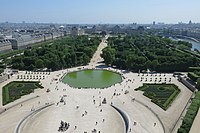

Historically, Burgundie has in general, but on the Ile Burgundie in particular, developed a style of garden/park known as the ort a la themis, literally flower gardens of Themis, the Istroyan titaness of order. This style of garden is based on symmetry and the principle of imposing order on nature. These grand displays of man's might have been cultivated over centuries of the minor princelings of outer Latuim to demonstrate their authority not only over their subjects but also over nature itself. In Burgundie in general there is a sense that the sea is perfect as it is and should be accepted but that land must be tamed and altered to fit the needs of mankind.
Bonsai

In keeping with the ort a la themis philosophy, Burgundie has imported many ideas for parks and gardens from its former colonies. Chief among them is the art of bonsai. The roots of Burgundie's fascination with bonsai can be traced back to Oyashima's colonial era, spanning the 17th to the 19th century. Bonsai, the art of cultivating miniature trees, captivated the Bergendii settlers and merchants in the Far East Colony, with its precision, artistry, and connection to nature. The Bergendii traders' fascination with bonsai laid the foundation for its eventual adoption in Burgundie. As they returned home, they brought with them not only bonsai trees but also knowledge about the art of bonsai cultivation. Bonsai initially captured the attention of Marialanus's ducal court which was renowned for its patronage of the arts, embraced bonsai as a symbol of refinement and sophistication. The court displayed bonsai trees in their palaces, fostering a sense of appreciation for these miniature masterpieces in the 1650s-onward. In the late 17th century, under ducal patronage, other aristocrats, scholars, and botanists in Marialanus began to explore the art of bonsai. These early enthusiasts sought to replicate the northern Dolongese techniques and styles. The spread of bonsai cultivation clubs and societies further contributed to the growth of this art form in Burgundie in the 18th century. During the 18th and 19th centuries, bonsai in Burgundie evolved from a royal fascination into a broader cultural phenomenon. Bonsai became a status symbol, representing refined tastes, patience, and a connection to nature. During the Enlightenment era in Burgundie, a premium was on knowledge, aesthetics, and the pursuit of individual interests. Bonsai, with its emphasis on meticulous care and creativity, aligned perfectly with the intellectual currents of the time. Many philosophers and thinkers of the Enlightenment admired bonsai as a metaphor for the human condition and the pursuit of perfection. Bonsai's popularity extended to the public sphere. Botanical gardens in the newly formed Burgundie began to feature dedicated bonsai collections. Public exhibitions and displays allowed a broader audience to appreciate the art form, further elevating its cultural significance. By the 19th century, bonsai had firmly entrenched itself in Burgoignesc culture, leaving a lasting impact on art, literature, and philosophy. Bonsai's emphasis on proportion, balance, and harmony found resonance in Burgoignesc art, particularly in painting and sculpture. Artists drew inspiration from bonsai's aesthetic principles, incorporating them into their works. Bonsai's philosophy of patience, respect for nature, and the impermanence of life had profound implications on Burgoignesc philosophical thought. Existentialist thinkers, in particular, drew connections between the art of bonsai and the human experience, exploring themes of growth, change, and the passage of time. In the 20th century, Burgundie's bonsai culture continued to thrive and evolve, with contemporary enthusiasts pushing the boundaries of the art form. Bonsai artists in Burgundie began experimenting with new species, styles, and techniques. This innovation led to the creation of unique Burgoignesc bonsai styles that blended traditional Oyashimaese techniques with local influences. It was also used after both Great Wars as a convalescence for severely traumatized soldiers who still had the manipulation to maintain bonsai. Many memorial parks and gardens to victims of those wars have magnificent examples of bonsai. To this day there is a still strong connection between wounded veterans of the Burgoignesc Security Forces and the art of bonsai. Many of the best bonsai gardeners in Burgundie are veterans of the Burgoignesc Security Forces. Burgundie's bonsai culture gained international recognition, with Burgoignesc bonsai artists participating in global exhibitions and competitions. This global exposure not only reinforced Burgundie's status as a hub for bonsai but also allowed for cross-cultural exchanges with Oyashimaese and other international bonsai communities.
City and Provincial parks
Crown and national parks
Architecture
-
Typical Burg Suburban house in Equatorial Ostiecia.
-
Key example of monumentalism and the City Beautiful Movement.
-
More examples of monumentalism with broad vistas and wide boulevards, note the modernist concept of the separation of functions.
-
One of the best examples of blending Renaissance du Centenarie with local styles in Alcairet
Maritime Deric and Faramountesc Rococo
- Faramountesc rococo 1730s-1760s
Maritime Deric Rococo
The Rococo architectural style occurred from the 1730s-1760s in Maritime Dericania primarily in the statelets that had extensive colonial holdings at the time, the Duchies of Bourgondi, Martilles, and Marialianus. It is most evident in the palaces that were built at the time by to dukes for themselves and for visiting dignitaries. They were exceptionally ornamental and dramatic and meant to show off the excessive wealth the colonial possessions afforded the dukes, it is ironic that the exorbitant cost of these palaces were a contributing factor to the fall of the Burgoignesc colonial empire.
Kilikas Brutalism
Neo Beaux-Arts
The Neo Beaux-Arts architectural style emerged in the late 19th century as a revival of the principles and aesthetics of the Beaux-Arts architecture that originated in the Holy Levantine Empire during the 17th century. This architectural movement, characterized by grandeur, classical elements, and a commitment to symmetry, played a significant role in shaping the design of public buildings, institutions, and cultural centers during the late 19th and early 20th centuries. Key features:
- Neo Beaux-Arts architecture is deeply rooted in classical architecture, drawing inspiration from ancient Istroyan and Latinic design. Buildings in this style often feature elements such as columns, pilasters, pediments, and porticos, echoing the proportions and ornamentation of classical temples and structures.
- Symmetry is a hallmark of Neo Beaux-Arts architecture. Buildings are typically designed with a central axis and a balanced arrangement of architectural elements on either side. This emphasis on symmetry creates a sense of harmony and order.
- Neo Beaux-Arts buildings are known for their rich and intricate ornamentation. Elaborate cornices, friezes, and decorative motifs such as garlands, festoons, and classical sculptures are common. This attention to detail adds to the grandeur of the structures.
- The architectural style incorporates various classical orders, including Doric, Ionic, and Corinthian. These orders dictate the design of columns, capitals, and other architectural elements, lending a sense of historical authenticity.
- Neo Beaux-Arts buildings are often characterized by their monumental scale. They are designed to be imposing and impressive, commanding attention and conveying a sense of importance and civic pride.
- Neo Beaux-Arts architects often adhere to the principles of Beaux-Arts planning, which prioritize axial alignment, hierarchy of spaces, and a clear circulation plan. This approach ensures that the building serves its intended purpose efficiently and elegantly.
- Use of Classical Materials: Neo Beaux-Arts buildings are typically constructed using classical materials such as stone, marble, and terracotta. These materials contribute to the durability and timelessness of the architecture.
The development of Neo Beaux-Arts architecture can be traced back to the École des Beaux-Arts (School of Fine Arts) in Vilauristre, Duchy of Bourgondi, founded in the 17th century. This prestigious institution played a pivotal role in training architects and promoting the Beaux-Arts style. However, the Neo Beaux-Arts style, as it is recognized today, emerged in the late 19th century and gained prominence in Burgundie. Neo Beaux-Arts architecture reached its zenith during the early 20th century. Many important public buildings and institutions adopted this style, including courthouses, libraries, museums, and government structures. By the mid-20th century, however, architectural trends began to shift away from the classical and ornate Beaux-Arts style. Modernist movements and a preference for simplicity and functionality influenced architectural design. However, elements of Neo Beaux-Arts continued to be incorporated into contemporary buildings, demonstrating the enduring appeal of its classical aesthetics.
Art Nouveau
Main article: Art Nouveau in Burgundie
Art Nouveau, also known as "New Art," was a highly influential artistic movement that emerged in the late 19th and early 20th centuries, primarily in Levantia. This movement encompassed various art forms, including architecture, and sought to break away from the rigidity of academic art and embrace more organic, fluid, and ornamental designs. Art Nouveau architecture is characterized by its emphasis on curvilinear forms, intricate detailing, and a fascination with nature and the natural world. Key features:
- Art Nouveau architecture is renowned for its sinuous and flowing lines. Buildings often feature undulating facades, curved balconies, and organic, plant-like motifs. The use of curves creates a sense of movement and dynamism.
- Elaborate ironwork, often in the form of decorative railings, balconies, and gates, is a hallmark of Art Nouveau architecture. These ironwork elements are typically designed with organic motifs, such as vines, flowers, and leaves, and add a sense of delicate craftsmanship to the buildings.
- Art Nouveau architects drew inspiration from the natural world, incorporating stylized botanical and floral motifs into their designs. These motifs can be found in stained glass windows, ceramic tiles, mosaics, and decorative details throughout buildings.
- Art Nouveau often embraced asymmetry, departing from the strict symmetry of earlier architectural styles. This allowed architects to create dynamic and visually interesting compositions.
- While Art Nouveau architects still employed traditional materials such as stone and brick, they also embraced new materials of the era, including cast iron and reinforced concrete. This flexibility in material usage contributed to the innovative nature of the style.
- Art Nouveau architects believed in the total work of art, where architecture, interior design, and decorative arts were seamlessly integrated. This approach led to the creation of immersive, harmonious environments.
- Art Nouveau buildings often featured facades that were not symmetrical, with irregularly placed windows, entrances, and decorative elements. This asymmetry added to the style's sense of organic and natural flow.
The Art Nouveau movement emerged in the late 19th century and reached its zenith from 1890s to the early 1900s, just as Burgundie was forming its identify as a nation. The style was perfect for a new nation as it was a reaction against the historicism of the 19th century, which had often copied past architectural styles, like Neo Beaux Arts. Architects and artists of the movement sought to create something entirely new and modern. It also took influence of Oyashimaese art, particularly ukiyo-e woodblock prints. Artists were captivated by the asymmetry, flowing lines, and emphasis on nature found in Oyashimaese prints. This sense of internationalism made the new nation feel important, and global, while also recalling the massive Burgoignesc colonial empire.
Neo Art Nouveau
Neo Art Nouveau architecture is a revival of the Art Nouveau style that emerged in the late 19th and early 20th centuries. Characterized by its emphasis on organic, flowing forms, ornate detailing, and a fascination with nature, Neo Art Nouveau architecture brings the aesthetics of the past into contemporary design. This style is marked by a fusion of tradition and innovation, celebrating the timeless elegance of Art Nouveau while adapting to the needs and materials of the modern world. Its revival movement was popular from 1993-2031 called Centennial Rival Style (Burg): Renaissance du Centenarie) or Bicentennial Style improved as building techniques allowed for grander scales in the revival.
Key features:
- Neo Art Nouveau architecture retains the sinuous and flowing lines of its predecessor. Buildings often feature undulating facades, curved balconies, and decorative elements that mimic the shapes of plants and natural forms. These curvilinear designs create a sense of movement and fluidity.
- Stylized botanical and floral motifs are a hallmark of Neo Art Nouveau architecture. These motifs can be found in decorative elements such as wrought ironwork, stained glass windows, ceramic tiles, and mosaics. The designs are often intricate and celebrate the beauty of nature.
- Similar to the original Art Nouveau style, Neo Art Nouveau often embraces asymmetry, departing from the strict symmetry of earlier architectural styles. This allows architects to create visually dynamic and whimsical compositions that evoke the spontaneity of nature.
- While Neo Art Nouveau architects draw inspiration from the past, they also embrace modern materials and construction techniques. This fusion of tradition and innovation allows for the creation of sustainable and energy-efficient buildings that pay homage to the historical style.
- Neo Art Nouveau values the integration of art and craftsmanship, upholding the tradition of the total work of art. This approach ensures that architecture, interior design, and decorative arts work harmoniously together.
- Many Neo Art Nouveau architects prioritize sustainability and eco-friendly design principles. This reflects a contemporary concern for the environment and a desire to integrate architectural beauty with responsible construction practices.
The emergence of Neo Art Nouveau architecture can be understood as a response to a renewed interest in historical styles, a desire for more expressive and ornate designs, and an appreciation for the natural world. It started in the 1990s with the BurgunFri movement and has blossomed since them. As concerns for the environment grew, Neo Art Nouveau architecture resonated with those who wished to reconnect with nature and incorporate sustainable design practices into their buildings. It also took wing as new technologies and innovations in engineering caught up to the whimsical nature of the style. It also paid homage to the founding moments of Burgundie as a unified nation and the House of Palacin really leaned into that as they established their dynasty in the early 2000s.
Religious architecture
Religious architecture in Burgundie, as it does in all places, reflects the core tenants of the religions adherents. Levantine Catholic Churches are large, grand, and gilded while Mercantile Reform Protestant churches are typically smaller, austere, and plain. These design choices reflect the religious ceremonies they house. The Catholic church, especially the cathedral is a testament to the grandeur of the Catholic hierarchical system, its opulence is the homage it pays to the Almighty. These domed monoliths stand broad as they gather the whole of the flock within its columned and vacuous halls to take the sacraments. In contrast, the white clapboard church of the Mercantile Reform Protestant is narrow and tall with its pointed steeple aspiring to God as it reaches towards the Heavens. Within its sanctuary are divided and simple pews for the chosen few to profess their faith. While a community may only have one Catholic church it will have scores, if not hundreds, of Protestant congregations.
Nature and architecture
Both because of the influence of Art Nouveau in Burgundie and the concept of ort a la themis nature and architecture have a symbiotic relationship in Burgundie. The tropical climate of most the Burgoignesc thalattocracy the need for cooling long predates the development of air conditioning. Passive cooling has been a key element of Burgoignesc architecture since ancient times. In more modern times, as mechanical cooling became more ubiquitous, these passive cooling techniques become less a requirement and more a decorative feature. In a more climate conscious world, indoor-outdoor living has become even more prevalent as a way to stay passively cool without using air conditioning.
Monumentalism and City Beautiful
Monumentalism and City Beautiful are closely intertwined in Burgoignesc urban planning and development. Monumental architecture was a key tool in Burgundie's City Beautiful movement's efforts to create impressive and inspiring urban landscapes. Following the unification of Burgundie and the required rebuilding of cities devastated in the First Fratricide, and also to demonstrate it's cultural dominance over the Dericanian's, Burgundie embraced Monumentalism and City Beautiful as it's driving urban planning doctrines.
Architectural Monumentalism in Burgunie
Monumentalism in architecture focuses on creating large-scale, imposing structures that evoke a sense of awe, power, and permanence. These buildings often employ classical elements like columns, arches, and domes, and are typically made of durable materials like stone or concrete.
Key Concepts of Monumentalism:
- Scale and Grandeur: Monumental structures are designed to be impressive and visually dominant within their surroundings.
- Classical inspiration: Many monumental buildings draw inspiration from ancient Istroyan and Latinic architecture, incorporating their elements and proportions.
- Symbolism: Monumental architecture often serves as a symbol of power, authority, or national identity.
- Permanence: These structures are built to last, using materials and construction techniques that withstand the test of time.
- Public Spaces: Monumental buildings often shape public spaces, creating grand plazas, squares, or boulevards.
City Beautiful Movement in Burgundie
The City Beautiful movement, which emerged in the late 19th and early 20th centuries in Levantia as a reaction to the Industrial Revolution, sought to improve the aesthetic quality of cities through the creation of grand boulevards, parks, and civic centers. It drew heavily on monumental architecture to create visually impressive urban environments.
Key Concepts of City Beautiful:
- Beautification: The primary goal was to make cities more visually appealing and uplifting.
- Civic pride and pride of place: The movement aimed to instill a sense of civic pride and identity through grand urban spaces.
- Monumental architecture: City Beautiful plans often incorporated monumental buildings like museums, libraries, and government structures.
- Community parks and grand green spaces: The movement emphasized the importance of parks and green spaces for the health and well-being of urban residents.
- Order and planning: City Beautiful plans were characterized by orderly layouts with wide boulevards and symmetrical arrangements of buildings.
Art
Theater

Opera

Opera (Burg: theatre d'Opera), has long been a form of "state theater" in southern Levantia. The building of Opera houses both national and municipal was seen by many early modern rulers as a form of public service and welfare. Opera was first formally performed in the Duchy of Verecundia in 1597 and picked up as an Imperial preference in the mid 17th century. Princlings all across the Empire took up, to varying degrees, the clarion call to develop Opera Houses and Opera companies. The Duchies of Marialanus, Martilles, Faramount, and Bourgondia were prime examples of state centric opera development.
This form of theater has long been integral to the cultural scene of the Burgoignesc Metropole. Opera has long been a form of "state theater" in southern Levantia and thus its themes are often to serve the glorification of the state and its leaders. In the mid-20th century this changed
Opera has been a part of the global Burgoignesc brand since the 1970s. Following the Second Great War and Operation Kipling the war weary Burgoigniacs sought to define Burgundie by other means instead of by its centuries of military intervention. Touring companies were created to bring the fine arts of Burgundie to the world. Opera troupes were paired with orchestras, corps deBallais, and art exhibitions. These “culture fleets” tour the world to this day ensuring that Burgundie is synonymous with high culture the world over.
Music
Folk music
Music dellas carboniers
This is a form of folk music typically sung by coal miners, like the Les Carboniers della infer. It is typically accapella and sung in an acoustic environment where the echo and reverberation are utilized as a member of the group, like in a deep mine. This has led to the development of special concert halls being built in the coal regions of Burgundie's Esquinia and Alexarmes. Its notable for its use of the head voice and short phrases, so as not to require a deep breath in the mines, bringing in coal dust to the lungs. It also utilizing a disproportionate amount of humming, again in an effort to reduce the ingestion of coal dust. It often slow and rhythmic to match the average swing of a pick and other mining tools.
Topics often include Hell, toil, torment, the working man, servitude, darkness, loss, and mortality.
Prenent l'aire
This is a form of folk music typically sung sailors, like the Les Marins d'Iroise. It literally means "taking the air", in reference to the healthy ocean air. It is typically sung with musical accompaniment. It is a broad genre of music without a standard meter and each ship typically had its own variations on the standards. Its sung almost exclusively in the chest voice, using long broad phrases, requiring deep breathing, hence its name.
Topics often include Heaven, freedom, mythical figures (mermaids, sea monsters), far off ports, and women.
Music partisæ
This is a form of folk music typically sung soldiers, like Cor della Armee. It literally means "partisan music", in reference to the factionalism of the Fraternal Wars. It is typically accappella and sung in pace with the march.
Topics often include death, battles, women, comrades, and valor/glory.
Music clezmeuer
Orchestral Music
Unlike many of its Occidental compatriots the ochestras of Burgundie are composed not of violins, violas, cellos, and basses but rather include some archaic and ethnic instrumentation. While many Occidental orchestras are composed of instruments played with a bow, Burgoignesc orchestras have a combination of bowed, picked, and plucked instruments.
In descending order of its typical register the instruments are:
- Violin
- Hardanger fiddle
- Vihuela
- Lute
- Clàrsach
- Lirone
- Viola da gamba
- Cello
- Cello da spalla
- Violone
- Octobass
Dance
Ballet
Ballet (Burg:Danse deBallais) or more colloquially Ballais, was first formally performed in the Duchy of Marialanus in 1489. The dance has long been integral to the cultural scene of Burgundie. The various principalities, duchies, and that now make up the modern country of Burgundie are well documented to have created two of the four schools of modern ballet, Ballais Burgones and Ballais Faramountagne. Ballais is a mandatory course of study in Burgoignesc schools from 1st grade through high school graduation. Participation rates remain high as many universities and businesses maintain corps du Ballai. Ballais Burgones is the official dance of the country and as such is afforded a prominent part in most demonstrations of national spirit. Participation rates in amateur ballet companies are, on average 5-15% in any municipality. Communities typically have professional or semi-professional ballet companies associated with them and competitions are common spectacles. While less common over all, Ballais Faramountagne is popular in Faramount. The Metropole Forces of the Army of Burgundie have ballet companies down at the Divisional level, but some regiments and Brigades also maintain their own corps du Ballais. Ballet has been a part of the global Burgoignesc brand since the 1970s. Following the Second Great War the war weary Burgoigniacs sought to define Burgundie by other means instead of by its centuries of military intervention. Ballet was an obvious choice as it demonstrated the poise and grace of Burgoignesc high society but also the potential explosive power of its working classes. Some enterprising ballet dancers petitioned for the Imperial Burgoignesc Ballet School to be opened in Urceopolis, Urcea, and in 1968 it was granted a charter by the Urcean and Imperial crown. The prowess and finesse of the Burgoignesc dancers was soon recognized beyond Urcea. Touring companies were created to bring the fine arts of Burgundie to the world. Ballet companies were paired with orchestras, theater troupes, and art exhibitions. These “culture fleets” tour the world to this day ensuring that Burgundie is synonymous with high culture the world over.
History of Ballet
Ballet is estimated to have been first formally performed in the Duchy of Marialanus in 1489 at the wedding of the Duke’s son to the eldest daughter of the Duke of the newly formed Duchy of Martilles. The wedding ceremony we spectacular and much admired by those of the Imperial court. It became de rigueur for the nobles to follow suit. The dance master, Joan-Paul deBallais, was in such high demand that the Imperial Court indentured him as the Imperial Dance Master and formed the deBallais School. DeBallais’s dance, as it become known, spread from the imperial court to the palaces of the Empire as the official court dance and the defining cultural phenomenon of the 17th-18th century in southern Levantia. Where early court ballet differed from its predecessors, is that it was a secular, not religious happening. It was a carefully crafted mixture of art, socializing, and politics, with its primary objective being to exalt the State. The Imperial Court of the Holy Levantine Empire maintained a large ballet complement and recruited from across the world. The Levantine high culture scene was considered one of the best, with some of the most enduring musicians of the Baroque period. To demonstrate their wealth and to curry favor with the emperors, some dukes and princes across the Empire developed ballet schools of their own to cultivate a healthy stock of dancers to be bargained with in their dealings with the emperor. One such duchy was the Duchy of Burgondia, who in 1507, formed a deBallais school of their own. The school was housed in the ducal palace and formed, with the Orchestral School, the foundation of Burgoignesc cultural court life. The Royal Faramount deBallais school was formed in 1588 and played a key role in the Imperial court’s recruitment of dance masters and young performers. During the Union of Magnia-Burgondia, the deBallais school in Vilauristre was influenced by the dynamicism and power of the Magnian Kingdom’s Slavic folk dances. The blending of the smooth and effeminate nature of the court dance with the striking and masculine forms favored in Magnia created a new genre of the dance called ‘’Ballais Burgones’’.
Nationalist Ballet
‘’Ballais della Cort’’ continued as the official dance of the Holy Levantine Empire through the 1830s. As the 19th century saw the rise of nationalism, it saw music and dance being influenced by local folk themes. By the 1820s ‘’Ballais della Cort’’ was considered out of fashion and variety of principalities and duchies took the initiative to demonstrate their local variations on the form. Ballais Aeglish, Ballais Burgones, Ballais Faramountagne, and Ballais Verecundiano were particularly popular. As these regional influences changed the classical dance of ballet there was an overall shift in the style and appetites for its performers. The emergence of pointe work, the dominance of female dancers, and longer, flowy tutus that attempt to exemplify softness and a delicate aura. This movement occurred during the early to mid-nineteenth century and featured themes that emphasized intense emotion as a source of aesthetic experience as opposed to a story intended to exalt the state. The plots of many romantic ballets revolved around spirit women (sylphs, wilis, and ghosts) who enslaved the hearts and senses of mortal men. These move away from the participative nature of the ‘’Ballais della Cort’’ and became spectacles to be watched by a seated audience.
Cinema
Literature
Fashion
Burgoigniacs are traditional, formal, and conservative in their style of dress. Women wear dresses, skirts, and pleated trousers in equal measure, often paired with a cardigan or shawl. Older Burgoignesc men are rarely out without a jacket, younger men without a sweater. All Burgoigniacs wear headgear, for women in less formal situations a scarf is common, and on more formal occasions elaborate hats or fascinators are de jure. Meanwhile
The stormy weather off of the Kilikas Sea and the cooler climes of Burgundie often require that most people carry an umbrella or a rain slicker, regardless of the weather at the time. Particularly on the Ile Burgundie where sudden squalls are common during hurricane season. Due to its maritime history, most Burgoignesc casual wear nautically inspired garments and are considered ever-ready to hop on a yacht should the need arise.
Role of Fashion in Society
Fashion is incredibly important in Burgundie as a signifier of status, type of employment, and wealth. Headgear in particular is
Formal Wear
Professional Dress
Casual Wear
Prep (abbreviation of the word Preparatoria) refers to a subculture in the Burgundie associated with the old private university-preparatory schools in the Duchy of Burgundie. The terms are used to denote a person seen as characteristic of a student or alumnus of these schools. Prep has become a colloquialism in the Burgundie and across Levantia and the Kilikas and has become synonymous with Burgoignesc culture. Characteristics of preps in the past, include a particular subcultural speech, vocabulary, dress, mannerisms, etiquette, reflective of a Burgoignesc upper-class upbringing.
Some typical frober styles also reflect traditional upper-class leisure activities, once associated with the wealthy Maritime Dericanian nobles who once had a strong political and social position in the Holy Levantine Empire, such as polo, sailing, hunting, fencing, crew rowing, lacrosse, golf, tennis, rugby, squash and swimming. This association with Ultmarian inspired outdoor activities can be seen in forber fashion, through stripes and colors, equestrian clothing, plaid shirts, field jackets, and nautical-themed accessories.
Examples of Prep attire include argyle sweaters, crewneck sweaters, grosgrain or woven leather belts, chinos, madras, Burgunshorts, button down Oxford cloth shirts, pearl necklaces and earrings, gold bangle or large chain bracelets, penny loafers, polo shirts (often with a popped collar), and boat shoes.
Overseas Styles
Media
Newspapers
Radio
Television
Social Media
Podcasts
Sport
polo, sailing, hunting, fencing, crew rowing, lacrosse, golf, tennis, rugby, squash and swimming
Falconry
Hunting
Sailing
Fencing
High fencing
Common fencing
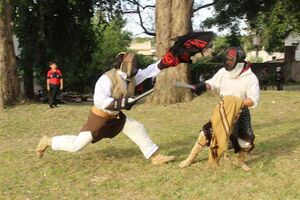
Common fencing (Burg: escrime de las plebes) is a type of large knife fighting, traditionally practiced by those not allowed to carry swords after the Great Confessional War, namely peasants and the burgeoning bourgeoisie. The knife used is the navajas (Burg: lame de cencha lit. sash blade because it was often concealed in a sash).
Horse racing
Maritime Dericania engaged in horse racing to varying degrees until the 1790s when steeple chasing became ubiquitous across the Kingdom of Dericania. Minor, informal races had occurred across the Kingdom prior to this but it become an unofficial sport of the kingdom around this time. As feudalism fell and professional armies rose across the southern portions of Dericania, young professional cavalry officers sought ways to train and compete. By the 1810s in the few principalities that could afford a professional cavalry corps were requiring forms of flat racing and steeple chasing as part of military training. This became associated with the dashing appearance of cavalry officers and became associated with the officer class and civilian landowners took up the sport as a demonstration of status. By the 1830s, nobles and generous landowners would gives days off to their tenant farmers on race days and it became a joyous communal holiday. The later half of the 19th century, theSouthern Levantine Mediatization Wars saw the dissolution of the aristocracy and as such their grand estates. This coincided with the industrial revolution in Burgundie, which when combined saw workers flooding into the coastal cities. Horse racing became a rare phenomenon and was typically was a game played between wealthy friends rather than a spectator sport. For nearly 20 years horse racings prominence waned and almost disappeared. However, in the 1890s the New Stud Movement revived horse racing in Burgundie. In 1892, future Imperator ofCaphiria Juvano Baldolianti, was granted patriarchy of House Tervarinus by Imperator Arieri II. As part of an austerity plan he sold off his father's race horses. The gens des mejans looking to demonstrate their wealth, but separate themselves from the aristocrats of old, flocked to the various auctions and formed Burgoignesc Breed Registry to maintain records of the new studs they were creating. Of the approximately 1,000 horses in the Tervarinus stables, 629 were brought to Burgundie. Horse racing renewed itself as a spectator sport for the working classes who were lucky enough to have a benefactor who owned horses. For the gens des mejans it was an all out competition, not just on the race track, but who could bring bigger crowds, build bigger and more opulent race tracks, and who could breed faster horses. Concurrent with the rise in the interest in human eugenics, equine eugenics became a craze in the early 1900s. Studding fees became astronomical as the pseudo-science purported to become more exacting. The Burgoignesc Breed Registry's recording fees also sky rocketed and the industry of horse racing and its affiliated services became a driving economic factor in many of the upland regions of the country. It was also one of the first legal forms of gambling in Burgundie.
Social ideals
Marriage and divorce
In Burgundie newly married women are more likely to be in their first marriages, more likely to have BA degrees or higher education, less likely to be under age 25, and less likely to have own children in the household, which all impacts the divorce rate and gives Burgundie a fairly low divorce rate for a country with legal divorce.
Given that newly married couples are older and more highly educated, Public Health officials predict the Burgoignesc divorce rate will continue to drop.
Family structure
Families in Burgundie are typically small, two parent affairs with Bergendii families having 1.75 children, Feinii families have 2.1 children, and immigrant communities vary, but collectively having an average of 3.2 children. In most cases both parents are working and the basic family unit is the nuclear family. Extended families do not typically live together and may even live a world apart.
Contraception
Becoming legal in the 1950s as a result of the Burgoignesc Women’s Liberation movement, guaranteed access to contraception has faded from general discourse because of its wide acceptance and vast popular support. The Catholic Church has taken their protests to the pulpit but by the 1980s had lost steam even there as parishioners turned away from the church starting in the 1970s, many young people citing the Churches stance on contraception as a reason.
Induced Abortion
Becoming legal in the 1950s as a result of the Burgoignesc Women’s Liberation movement, induced abortion has faded from general discourse because of its wide acceptance and vast popular support. Access is guaranteed by law and is available at most hospitals that provide maternal-fetal medicine. The Catholic Church has taken their protests to the pulpit but by the 1980s had lost steam even there as parishioners turned away from the church starting in the 1970s, many young women citing the Churches stance on induced abortion as a reason. In the depths of Roln and Laclionia induced abortion is still socially taboo and is least likely to be practiced. These two areas also have the highest levels of unintended pregnancy, death or impairment of the mother and or child due to birthing complications, unmarried motherhood, parents without college degrees, lowest average income, highest gender pay gaps, and lowest levels of savings in Burgundie. These statistics are often cited as examples of why de-stigmatizing abortion remains important.
The government of Burgundie does not specify when in the gestation process a fetus becomes a person. The medical community has determined that they will not usually conduct abortions after the conclusion of the second trimester out of consideration of the health of the mother. Due to the flexibility of the law, extreme circumstances may warrant an abortion at any time, even in the third trimester.
Protest movements
Because of its entrenched status in the vast majority of society, there is no such thing as a pro-choice movement as this standpoint is considered the norm in Burgundie. An extra-liberal movement started in 2024 that seeks to criminalize the denial of access to abortions or other women’s health services. This group posits that denying the full spectrum of women’s health services is a breach of the mother’s human and civil rights. They seek to have laws codified to penalize parents, male sex partners, priests, and others who preclude mothers from seeking abortions or other proven women’s health services. Efforts to change the laws have been discussed on the floor in the Golden Council of Ten but no action has been taken as yet.
The small but zealous pro-Life movement exists in certain rural parts of Burgundie. The movement is small and generally ignored getting an average of 14 hours of news coverage per year. The pro-Life activists seek to end the guaranteed access to abortions specifically and do not take a stance on access to other women’s health services. They frame their argument as a protection of national security. Since all residents of Burgundie are required to participate in the Standardized Militia Program, pro-Life proponents claim that abortion is an act of treason by murdering “soldiers of Burgundie”. Further, since Standardized Militia Program is a requisite for citizenship in Burgundie, the movement claims that abortion is a denial of a chance of citizenship to deserving residents.
Children and parenting
The average age for mothers in Burgundie to have their first child in 28. This varies widely by province with the lowest average age in Roln being 22 and the highest being 32 on the Ile Burgundie. Having children in Burgundie is something that happens mostly after mothers have achieved the following:
- completed high school
- completed the Standardized Militia Program
- graduated from their terminal degree, most commonly a bachelors or higher
- completed 3 years of work
- gotten married, and
- bought a domicile
Having this background means that most children in Burgundie are intentional, well provided for, will go to institutions of higher education, will have parents who provide them the opportunity to travel internationally, and will have two parent households. This puts Burgoignesc children at an advantage over children from a number of different nations in Greater Ixnay. However, it means that the average Burgoignesc family is small. On average Bergendii families have 1.75 children and Feinii families have 2.1 children. Immigrant communities vary, but collectively have an average of 3.2 children. These small nuclear families mean that more time is devoting to parenting in contrast to general child-rearing, in which children may be expected to take care of each other.
Parenting
Because of the small size, intentional nature, and the high likelihood of the presence of two parents of Burgoignesc nuclear families, parents take the vast majority of the responsibility of rearing their own children. Traditionalist gender roles are blurred in Burgundie as roles are more likely assigned on meritocratic terms and through compromise. In approximately 16% of heterosexual Burgoignesc families, the male partner is the primary caregiver to the couple’s children. Because of its moderately long mandatory parental leave laws, Burgoignesc infants generally have a parent present 24hours for the first 14 months of its life. Following that children are often cared for by parents offsetting schedules when possible and/or seeking childcare alternatives. Wealthier families tending to engage private babysitters/tutors to watch children and edutain them until they are old enough to go to school. These people are highly regulated and often hold a Specialized Baccalaureate in Childcare or higher degrees in their tutoring field. Parents are entrusted with moral education but this is typically reinforced by the Church as 64% of young families reported attending church in the 2030 census. Parents also are responsible for creating a foundation of socialization and are encouraged to have their children play with others in their infancy both as a socialization tactic and also as a public health measure to expose them to as many pathogens for early antigen development. This approach is counter-intuitive to many occidental “bubble boy/helicopter” parenting styles, but in the context of a highly developed pediatric medicine sector is has been long proven to be successful in the long term. It does whoever mean that on the surface Burgoignesc children appear sicker than many other occidental children, but on average they are healthier adults.
Burgoignesc parents also allow their children space to play, explore, and make mistakes in a generally unsupervised environment. This is leads to the early establishment of critical thinking skills and creative problem-solving skills in Burgoignesc children who become highly capable adults.
Since culture is highly prized in Burgoignesc culture parents are encouraged to take their children to cultural events. The government makes admission to museums, theatres, historical attractions, and festivals free to families on a number of occasions throughout the year. This is further supplemented by free tour guides at applicable venues for children so that the parents can either enjoy it at their own pace or some time alone. Museums and historical attractions are particularly popular in the summer and it is common to see the venues packed with children and the cafes packed with parents.
Discipline is an important part of parenting in Burgundie. Children are expected to be respectful and quiet in public places and breaches of this norm is a reflection on the parents. Therefore, as part of the early socialization process, children are taught the tenants of resecting their elders, honoring their family, and prudence in social situations. There is not as much of a taboo regarding corporeal punishment in public if a child isn’t behaving, but it extends only as far as slapping of the hands and posterior. Thusly, with heavy reinforcement from the Church, shame is a powerful aspect of Burgoignesc life.
Parental leave
Parental leave in Burgundie is 8 months paid leave, with an additional 4 months available to mothers at half pay. While it is common for mothers to take all of their leave consecutively, fathers have the flexibility to take their paid leave at a cadence agreed upon by their employer. Typically, fathers take a month following the birth of their children and then return to work saving the bulk of their remaining time until the end of the mother’s 8 months so that the child will have a parent present 24hours for the first 14 months of its life. The time a father spends at work between parental leaves is known in Burgundie as the ‘’Diesel Period’’ (Burg: Diesel periode), a joke on the low octane content in diesel fuel and the fact that due to lack of sleep it is a generally unproductive time. During this time the worker is given high volumes of menial, low risk tasks.
Sexual orientation
Race relations
Vice
Stimulants
- Chewing stimulants- The most commonly available chewing stimulants in Burgundie are Khat from Audonia and Gutka from Template:Alshar. They are considerably cheaper than tobacco products and generally more potent. Both are heavily regulated with some provinces banning them outright.
Khat in particularly villianized and is illegal in most provinces in Levantine Burgundie. Its use is associated with the Kharkaars, criminality, and poverty. The import of Khat is illegal but it is suspected that the Martillian Mafia makes millions on its Khat smuggling each year.
Gutka is generally legal but its manufaturing and labelling is highly scrutinised. Because of its village manufacture and its non-standardized packaging the versions commonly available are not legal. Gutka sadak (Eng.: Street gutka), unregulated, is the most commonly used and it is not legal in any part of Burgundie. It is very inexpensive and by nature its potency and admixtures vary wildly. It is most popular with the south coastal Alsharite immigrant population in Burgundie but has a strong following in some lower class communities.
Depressants
Alcohol abuse
Commonwealth
Environmental stewardship
Social Programs
Social programs in Burgundie are formally administered through four avenues know as “the legs on which the table of the Burgoignesc banquet is set”. These four organizations are the Burgundie’s federal government, Burgundie’s royal government, the Catholic Church, and the Burgoignesc Board of Friendly Societies. These agencies meet every 3 years to determine a wholistic strategy for the alleviation of suffering and the improbvement of the welfare of all Burgoigniacs.
Community service
Volunteerism and the role of community organizations
Homelessness
Following the Great Peasants' Revolt in the Grand Duchy of Marialanus, Revenue Guardsmen were authorized under 1383 Burgoignesc Poor Laws statute to collar vagabonds and force them to show support; if they could not, the penalty was imprisonment.
Vagabonds could be sentenced to the stocks for three days and nights; in 1530, whipping was added, under the presumption was that vagabonds were unlicensed beggars. In 1547, a bill was passed that subjected vagrants to some of the more extreme provisions of the criminal law, namely two years servitude and branding with a "V" as the penalty for the first offense and death for the second.
Large numbers of vagabonds were among the convicts transported to the Punthite colonies in the 18th century.
Homelessness emerged as a national issue in the 1870s. There are no national figures documenting homeless people demography at this time. Jacob Ris wrote about, documented, and photographed the poor and destitute, although not specifically homeless people, in Port Diteaux tenements in the late 19th century. His ground-breaking book, How the Other Half Lives, published in 1890, raised public awareness of living conditions in the slums, causing some changes in building codes and some social conditions.
Port cities saw the greatest numbers of homelessness as those from the interior and the sailors coming from all across the world met in close quarters. The merchant class often felt under siege and, through generous philanthropy, attempted to assuage the influx through charity. This attempt to hold the problem at arm's length as well as a growing movement public health movement sparked the development of rescue missions, such as Burgundie's first rescue mission, the St. Mattius' Rescue Mission, founded in 1872 by the Franciscan monks. The homeless populations congregated around these areas, which became known as mission districts across Burgundie. In smaller towns, there were hobos, who temporarily lived near train tracks and hopped onto trains to various destinations. By 1909, the homelessness issue was declared a nation-wide epidemic, the first public health emergency in Burgundie.
The Great Depression of Burgundie, in the late 1920s and early 1930s caused a devastating epidemic of poverty, hunger, and homelessness. During this time there were two million homeless people migrating across the Burgoignesc Thalattocracy. Many lived in shantytowns they called "Chalets d'August" deriding the Great Prince they blamed for the Depression. Residents lived in shacks and begged for food or went to soup kitchens. Authorities did not officially recognize these Chalets d'August and occasionally violently removed the occupants for technically trespassing on private lands, but they were frequently tolerated out of necessity.
Following the costly victory in the New Burgundie Secession War, many returning veterans, suffering from the emotional trauma of the war, were unable to hold long-term jobs. To address this and the homelessness epidemic, the National Infrastructure Development Program (NIDP) was formed and a works program was created. Using reparations money, infrastructure, mostly on the Ile Burgundie and in Ultmar, was maintained, repaired, and updated. 4.6 million men across the whole thalattocracy were put to work and the joblessness issue was almost eliminated. Only those who were employed by the program were able to receive benefits and for about 66% of the jobless and homeless population, this was acceptable. The remaining were physically and mentally unable to participate and were thrown into already overcrowded provincial hospitals.
Further complicating the issue was that in the 1950s, as part of the NIDP, new massive highways were built, most of which went through the major cities of Burgundie. Low-income and working-class neighborhoods were demolished without a resettlement plan, and a new population of homeless people were created and, as the largest of the NIDP projects were completed, many of its own laid-off workers joined the ranks. From a homelessness rate of 1.2:100 in 1946 to 18:100 in 1962, the numbers were much higher then at any time in Burgoignesc history. This, among other societal and ideological discontent, lead to a period known as the Great Tumult. Fear of another Great Peasants' Revolt or even a communist revolution soared and police and the local militias were used to violently suppress and break up any gathering of homeless peoples.
Furthermore, the Community Public Health Act of 1963 was a predisposing factor in setting the stage for modern homelessness in Burgundie. Long term psychiatric patients were released from state hospitals into Single Room Occupancies and sent to community health centers for treatment and follow-up. The move was an immediate disaster, and soon the mission districts across the Ile Burgundie and Ultmar were teeming with underserved peoples, both with and without psychiatric issues. In the early 1970s city planners, public health departments, social issues advocates, and development proponents alike identified that the homelessness issue was getting out of hand. Academic centers and design firms partnered, with government funding to design the city of the future, to address the needs of all Burgoigniacs.
The Great Society Act of 1974 started what has become known as the Second Burgoignesc Renaissance. It addressed a number of social issues across Burgundie, among them homelessness. The Act called for areas of compassionate refuge for the homeless within each major city and established the Royal Fund for Public Health. This alleviated the national government from having to tackle social issues, keeping the focus on capitalist policies instead of ideals of socialist degeneracy. The areas of compassionate refuge was a thinly veiled containment policy that established fixed borders to the mission districts of each major city and transferred the lands they were on into corporations of the Burgoignesc Crown Estate, thus exempting it from any local zoning ordinances. These areas became walless prisons as they were designed to keep the people within their limits. Harsh lighting, the forced centralization of disenfranchisement services, and the rezoning of nearby parks as buildable land made it clear that the homeless populations were expected to go to the mission districts and stay there.
Following the Great Burgoignesc Recession of 2004-2008, and yet another uptick in homelessness, public health attitudes changed and focused on re-enfranchisement. The mission districts that had long been left to their own devices, but with the establishment of the Crown Prince Guillem's Foundation in 1998 and the Great Prince's interest in public health issues, services that had long lacked were reinstated. Schools for the children, job training for adults, medical facilities and other essential needs functions were restored across many of the mission districts. Buildings that had long lay abandoned or in disrepair were rebuilt and turned into affordable housing. Those who lived in the communities were paid to maintain these new facilities to avoid their return to squalor and local residents were trained as auxiliary police, under the concept of community policing. In 2008 the estimated rate of homelessness in Burgundie was 8:100, by 2020, the number had been reduced to 3:100. This effort was not entirely selfless as the collected tax that the newly enfranchized population provides is estimated at 20% over the cost of the programs. While not every corporation was profitable, the profits of others were reinvested for a net gain. Economists predict that not only will the Crown Prince Guillem's Foundation recoup its investment by 2050 but that the Burgoignesc Crown Estate, through its ownership of the land, will have increased its value to well over $29 billion.
National service
Military service
Political service
Role of government
Gun control
Role of industry
Private sector socialism
The sense of commonwealth among the Bergendii is born from the ancient raiding traditions. Each man looked out for his fellow boat-mates as though they were his brothers. If the sailors were to die the men of the boat would adopt and support his wife and family until she remarried. When the raiders became "landed" the "boat bond" was continued in each hamlet. They became known as meal groups this meant that the bread winners were collectively responsible for feeding the hamlet at the evening meal. This sense of commonwealth continues to this day with the practice of meal group not only in the neighborhoods around Burgundie but also, starting in the 1920s the rise of public health concepts led major companies to adopt the meal group mind set. In the 1980s many companies were buying apartment blocks and high rises near their factories and subsidizing their rent in order as an incentive. These "company rows" had become standard practice and by the late 80s, every manufacturing plant offered housing to all of its employees. This form of private sector socialism staunched the rise of the communist movement in Burgundie because it staked the fortunes of the working class on the upper class. Communist theorists decried this move as exacerbating the issue of inequity, but by the 1990s the communist movement in Burgundie was essentially dead.
Role of monarchy
World view
Nationhood
Citizenship
Citizenship is offered to all by the 1853 Constitution. However, citizenship can only be accepted by those who complete the federal service requirement, ([[12 Labors of Heracles]). Anyone in the world is eligible for application to the Burgoignesc federal service but the most prestigious way to gain Burgoignesc citizenship for non-natives is to serve in the Burgoignesc Foreign Legion.
In this way Burgundie does not follow Jus sanguinis or Jus soli law and is one of the few countries in which all its citizens, native and non-native are naturalized.
Commonwealth of nations
League of Nations
National self-determination
Human rights
Genocide
Famine
Military intervention
Foreign aid
Foreign Culture
See Also
- Bergendii, Sintalians, Sondsteadish Tatars, Coscivians, Paulastrans
- Cultures of Levantia
- Cultures of Crona
- Demographics of Burgundie
Template:Burgoignesc overseas territories

